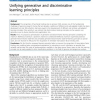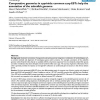85 search results - page 9 / 17 » Recognizing DNA Splicing |
ICASSP
2011
IEEE
12 years 11 months ago
2011
IEEE
Dynamic noise adaptation (DNA) [1, 2] is a model-based technique for improving automatic speech recognition (ASR) performance in noise. DNA has shown promise on artificially mixe...
BMCBI
2010
13 years 7 months ago
2010
Background: The recognition of functional binding sites in genomic DNA remains one of the fundamental challenges of genome research. During the last decades, a plethora of differe...
BMCBI
2006
13 years 7 months ago
2006
Background: Many vital biological processes, including transcription and splicing, require a combination of short, degenerate sequence patterns, or motifs, adjacent to defined seq...
BMCBI
2006
13 years 7 months ago
2006
Background: Automatic annotation of sequenced eukaryotic genomes integrates a combination of methodologies such as ab-initio methods and alignment of homologous genes and/or prote...
BMCBI
2006
13 years 7 months ago
2006
Background: Identifying functional elements, such as transcriptional factor binding sites, is a fundamental step in reconstructing gene regulatory networks and remains a challengi...


